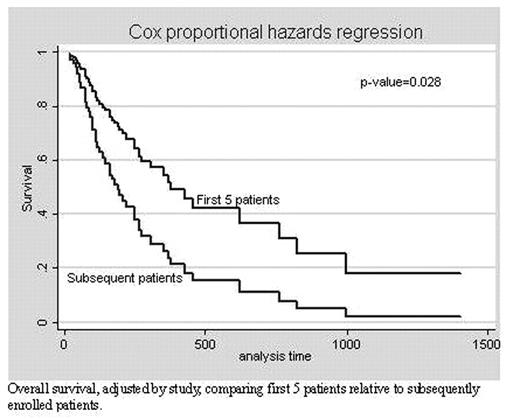Abstract
Early trials evaluating nonmyeloablative allogeneic hematopoietic transplant (NST) for metastatic renal cell carcinoma (RCC) have reported widely discordant results. We performed a meta-analysis of the published literature to identify prognostic factors for NST. However, known RCC prognostic factors are not often detailed in these studies, hindering the identification of patient differences among studies. We explored the order of patient entry as a surrogate marker for patient selection, hypothesizing that patient selection, rather than treatment differences, accounted for early promising results. Patient specific data and adequate follow-up were available for 76 patients from six studies. The rank of patient entry on each individual trial was recorded as well as ≥ grade 2 acute graft-versus-host disease (aGVHD), recipient age, recipient sex, response (partial plus complete), and survival. Multivariable analyses for response and survival were modeled using logistic and cox proportional hazards regression, respectively. The mean overall response rate was 22/76 (29%), with responses across individual studies significantly varying from 0% to 57% P =.009 by Chi-square). Median Kaplan-Meier survival was 263 days. Neither age nor sex was significantly ( associated with response or survival. Acute GVHD occurred in 42% of individuals and correlated with response (OR=9.9, P =0.012) but not survival (HR=1.53, P=0.28). When adjusting by study, later patient entry rank reduced the probability of response (OR=0.30, P =0.007) and survival (HR=1.89, P =0.006). Alternatively, being among the first five patients enrolled in a given study relative to subsequent patients, increased the probability of response (OR=6.69, 95% CI 1.95–39.1, P=0.005), even when adjusting for aGVHD, and afforded a survival benefit (HR= 0.45, 95% CI 0.022 −0.92, P=0.028). The prognostic strength of patient entry rank strongly suggests “entry bias” in patient selection. This bias potentially accounts for the large variation in outcome among studies and for the promising results in early studies. Entry bias analysis offers a novel method to assess early phase trials for selection bias, when detailed individual prognostic information is lacking. Further study is warranted to determine to what extent, if any, entry bias occurs in other clinical trial settings.
Author notes
Corresponding author


